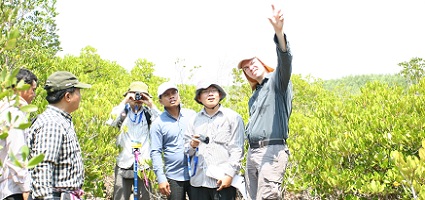FAO trains Cambodia to prepare for first ever national forestry inventory

By Botumroath Keo Lebun
(25.07.2014) Koh Kong - Braving a punishing sun, mushy ground and grimy labor, 22 Cambodian government officials participated in week-long vital work, which will culminate in the first significant assessment of the country’s forests since 1962.
The Royal Government of Cambodia (RGC) will use the inventory to obtain an accurate and reliable snapshot of its forests, its health, size, the species it contains, and the carbon content.
The inventory is part of a larger government effort to tackle climate change by reducing emissions from deforestation and forest degradation. Sustainable management of natural resources/forests in Cambodia will lead the way in the fight against global warming.
The national forestry inventory (NFI) is designed through field trainings and workshops for government teams and other stakeholders. Forestry officer Mathieu Van Rijn from the Food and Agriculture Organization of the United Nations (FAO) provides Lebuntechnical guidance to the government’s core team, preparing them to train more staff at the appropriate time as part of a capacity-building effort.
The training ensures that government staff is well acquainted with the NFI design, the field manual and the various field forms, and will be able to calculate basic parameter including stand volume and biomass.
Field Test Manual: On-the-Job-Training for the Core Team
The core team of officers, who visited Koh Kong province in southwestern Cambodia, was co-supervised by forestry officer So Than from the Ministry of Agriculture, Forestry and Fisheries.
The province is known for its vast mountain range, the Cardamoms, which offers a variety of landscapes, from dense evergreen rainforests to lowland swamps and coastal mangroves.

With a training manual and inventory sheet in one hand and a Khrama (Cambodian traditional scarf) in the other to protect from the sun’s ray, the core team was tasked to field-test the FAO’s manual for its suitability for field application /user friendliness.
Government officials also familiarized themselves with high-tech tools: a Vertex laser for distance measurement, measurement tape, a handheld GPS for location identification and an inventory form to be completed by each team.
Government officer Ngourn Sep, 45, who graduated from the government’s Prek Leap National School of Agriculture, and studied for seven years in Russia in the early 1990s, says that after his third training in Koh Kong and hands-on practice with the laser range finder, he is more confident to go out in the field with his team to do the job.
“After three field practices, I can now finally confirm that I have the required skills do the inventories,” Sep said, sitting on a log of wood, ready to receive information from his teammates.
Many officers including Sep complained that a major challenge in performing the forest inventory is their lack of the necessary knowledge to identify the tree species in the sampling plots. “Some sampling plots consisted of over 38 tree species. We spent too much time trying to identify the names of trees,” said Sep, adding that a local publication on identification of tree species would be useful in his line of work.
Overall, the success of the inventory will depend on the officers’ understanding of “what the data will be used for,” Than said.
At the end of the field mission, Than pointed out that the manual was well-designed for Cambodian officials to complete inventories, estimating that nearly all of the 22 officers are now well-equipped for this work.
